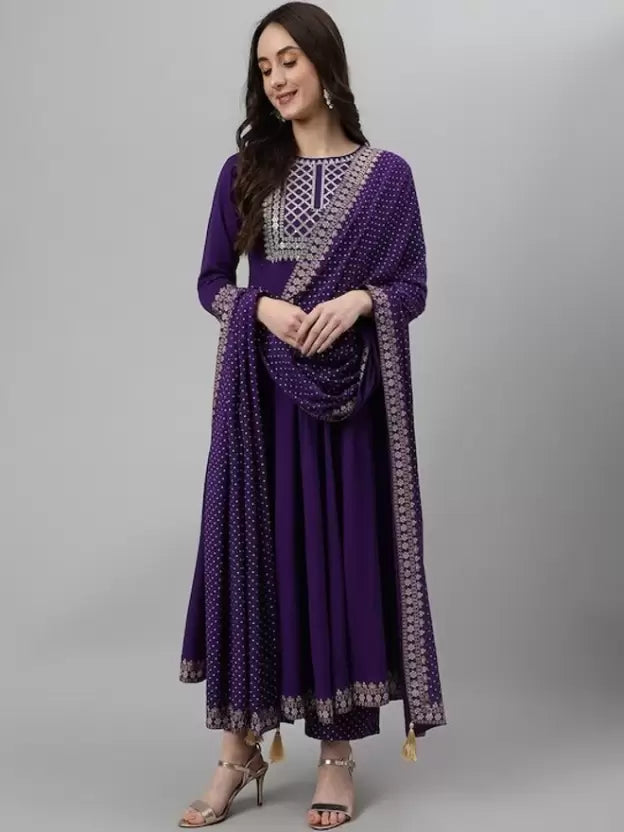
Indian Anarkali Ethnic Dress
Anarkali is an exquisite extravagant ethnic dress which evokes a long and deep traditions. It embodies the grandeur of its title. well-known dancer from the court of the Emperor Akbar who captured the heart of Prince Salim. Her exquisite beauty meant and she was awarded the name Anarkali that means "blossoming the fruit'.
Background
The story of Anarkali has been associated with the mysteries of romance, tragedy, even romantic love. While it's a popular story but there isn't any evidence or evidence that supports the story. This is a story of an unrequited love affair among the prince Salim and Anarkali along with the consequences of their cross-sex love-birds. Anarkali is a dancer in the court of the Emperor Akbar and wore attractive form-fitting curtas. The kurta was a tight fitting garment that reached waist and then began to swell to the knee. The dress was worn with the trousers, which were churidar. And the dupatta or stole was made of a transparent cloth.
Anarkali the name was used to describe in the past, had half or complete sleeves and modest necklines during at the time. The fabrics employed were silk brocades and cotton muslins and brocades as along with organzas, velvets as well as. Floral motifs and block printing, Kalamkari (patterns that were created with the pen) and gold threads adorned with semi-precious stones, or precious designs became fashionable due to the Mughal custom.
The dance that was performed in the courts of Emperor in the Mughal period was known as mujra. The dancers were attired with the style of the churidar, as in flowing and fitted Kurtas that were later described in the form in the form of Anarkali and Anarkali salwar suit.
It is thought to be that there was a Hindi film industry too is a key factor in the design of this gown. The Mughal-eAzam epic film was released in 1960 which featured the leading actress Madhubala dressed in a gown in the form of Anarkali. Then, during the 1970's, and into the late 1980's and onwards, it was the fashion, which never stopped. Recently, the dress was praised by prominent stars like Aishwarya Rao and Bachan Kareena Kapoor Vidya Balian along with many other famous celebrities.
The Anarkali the most popular dress of today is changing in order to be updated with the latest styles in the fashion industry. The use of synthetic material is blended with matching, and so is an incredible array of patterns including embroidery designs and embellishments.

Types
This is a representation of the ever-changing trends that are altering Indian traditional clothing, which remain in tune with the current global fashion. Alongside the timeless fabrics such as brocades cottons, silks, and synthetic fabrics are being incorporated into these days. Utilizing rich colors like gold, magenta silver, dark green combined with printed borders, embroidery patterns made of zardosi which feature floral backdrops along with Chinese collars are considered trendy. Anarkali bridal dresses are a hit all over the globe.
Style and Attire
The fabrics of this kind comprise of viscose, net, lace, and chiffon. The embroidery designs include Phool, applique, Patti Bagh, Chikankari, Kashmiri Kashida Soof, Gota, Ahir, Kantha stich, Kathiawari, Kutchhi, Badla patchwork, mirror work and many others. The hues of hues used in the creation of Anarkali isn't your typical. The colors of teal, ochre salmon, and fuchsia are mixed with other shades to create a fascinating mix.
The use of contrast colors is one of the best characteristics of these dresses. The clothes appear basic and elegant because of the embroidery around the neckline and on the sleeves. In some cases the Gota or lace may be incorporated on the neckline, at the waist, or in flares for an imposing look. Many embellishments or embroidery using solid colors modify the look of the dress. Likewise, simple prints or patterns can transform Anarkali a more informal outfit. This dress blends old and modern, with influences from Mughal traditional dress, combined with contemporary styles.
The Making
An ordinary Anarkali suit can take between two to three days to sew and will depend on the fabric made, its stitching technique, or the items that are embellished. It is generally coupled with a dupatta out of the same fabric along with an unveiled stole. There is a wide range of materials available along with a wide variety of mirrors, sequins Zari beads beads pearls and much more, but it's more practical to finish the outfit. Local tailors have the expertise and know-how to locate all of the required items quickly. Cost to have the garment stitched varies from Rs.800per up to Rs.1200$1200. The pattern and styles affect the price since there is more labor required. The cost of ready-made Anarkalis differ from Rs.2500and all the way to Rs.15000The designer versions can be located in the range of around about Rs. 25000 up to Rs.50000to Rs.50000.
Innovations
Modern trends include the look of a bustier with ornamental tie ups at the front as well as bodices that have patches. They use fabrics like net or chiffon, stitched over a crepe, brocade or brocade suit. Combining the churidar with an Anarkali is fashionable. The low backs and necklines of high necklines have been trendy.

Accessorizing
Anarkalis are a classic. Anarkali can be paired with light or heavy accessories in accordance with the ceremony and what style it is worn in. An extravagantly embellished dress can be a sure way to turn heads and needs light accessories.
Maintenance
The suit should be regularly dry-cleaned and kept away from direct the sun. Direct ironing is suggested. Anarkalis made of Anarkali made of cottons, chiffon nets, and in an array of lightweight fabric types can be worn throughout the summer. Silks and brocades are appropriate for cooler temperatures.
